From VenturaPublications.com
Harvard NZ1041 - A photo essay
By Robert Montgomery
Nov 4, 2012, 11:26
Click here to view Harvard decals at the Ventura Publications on-line shop
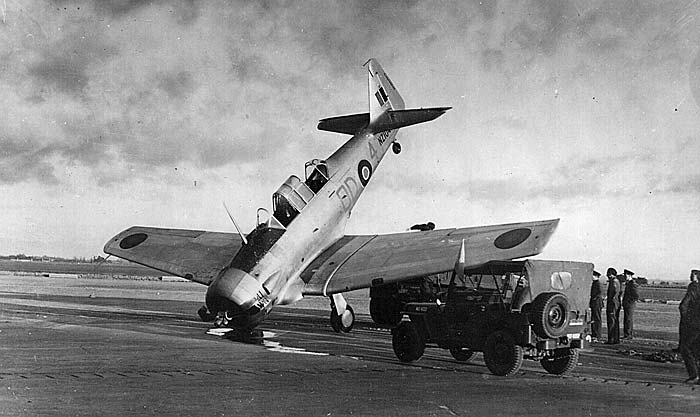 |
| (Robert Montgomery collection) |
Above. NZ1041 when serving on Ohakea with No.4 (F) OTU , following a taxi-ing accident on the afternoon of June 15th, 1945.
The accident occurred at 1611hrs; in the process of carrying out a "Test for Night Flying" the aircraft was being taxi-ed by a pilot of B Flt from the parking area to the take-off position when the brakes were "applied viciously", locking the wheels and causing the aircraft to skid in gravel before encountering the edge of the tarmac hardstanding and nosing over.
As the pilot had used only normal braking when manoeuvring the aircraft it was hought that an airman-fitter riding in the rear seat may have applied pressure to the brake pedals with his feet whilst adjusting the height of the seat. No injuries were sustained.
The pilot, Fg Off A.S. Mills, m.i.d., was an instructor on the OTU and had 300.05 flying hours on Harvards, 945.20 in total. He was regarded as "experienced and most reliable".
Arthur Stewart Mills (NZ427097) was on Course 37B at No.2 SFTS Woodbourne3, which commenced ITS on April 5th, 1943. He joined No.16(F) Sqdn in October that year and completed two operational tours on Kittyhawks, during which time he was credited with one enemy aircraft destroyed and another damaged. He subsequently completed one tour with No.22 (F) Sqdn, flying Corsairs. In all, Fg Off Mills completed 92 missions during 220 hours of operational flying. On July 20th, 1945 his Mention in Despatches was gazetted; he served in the RNZAF from July 9th, 1942 to February 24th, 1946, and remained in the Reserve of Officers until February 7th, 1957.
Camouflage and markings - NZ1041
At the time of this incident, NZ1041 had 687.10 airframe and engine hours; the R1830-AN-1 Wasp radial, serial no. 20480 had been installed on April 16th, 1943 (at the time this "unit" was assembled) - NZ1041 was Brought On Charge (or added to the RNZAF's inventory) on June 26th that year.
As a Harvard Mk.IIA, NZ1041's rear fuselage and tailplanes were of plywood construction; for ease of production the entire airfraime was finished with Aluminium paint. With the introduction of the "silver" finish broad yellow bands were applied above and below the mainplanes, extending from the outer-section attachment to the ailerons - NZ1041 would have been received marked thus but would by 1945 have been in service long enough for these to have been overpainted.
National insignia took the form of B-Type Roundels above the wings and C-Type below; C1-Type Roundels on fuselage sides, and corresponding "unequal width" Fin Flashes. The anti-glare area was Black, as were the NZ Serials on the rear fuselage; it is unlikely these were repeated beneath the wings in this instance. The propeller awas unpainted except for (a) the front and rear face of of each blade painted Yellow inwards to 4 inches from tip, and (b) the rear face of each blade painted Black from Yellow tip to centre-line of cowling rim.
The colours, as applied before delivery, were matched in accordance with the Army Air Forces Bulletin No.41, promulgated September 16th, 1940 (superceded by ANA Bulletin No.157 from September 28th, 1943):
Black No.44 (ANA No.604, Fed Std: 37038).
Insignia Red No.45 (ANA No.619, Fed Std 31136)
Insignia White No.46 (ANA No.601, Fed Std 595: 37875).
Insignia Blue No.47 (ANA No.605, Fed Std 595: 15044).
Identification Yellow No.48 (ANA No.614, Fed Std: 33538)
No.4 OTU's letter-number group OD-4 was marked in Red (this unit's "house colour"), as was the aircraft's "last two" - the number 41 - on the sides of the cowling. The upper section of the engine cowling was also painted Red. Any difference between the US and NZ manufactured Reds would have been negligible.
I have a listing of Harvard Allotmonts for the period November 1948 - October 1955 (less Oxrovwe `954 - February 1955); NZ1041's record commences on October 11th, 1950, when it was despatched from Wigram to Woodbourne for overhaul. From Woodbourne to Ohakea, and on January 30th, 1952 it was allotted to Shelly Bay for the Communications Flt at Rongotai, The entries close on September 8th, 1952 with its transfer from Shelly Bay (Comm Flt Rongotai) to Ohakea.
A second accident
The second of NZ1041's two accidents occurred on Friday, December 12th, 1952, while still with the Comms Flt. When landing on Whenuapai's 22 Runway at 1520 hrs the port wing dropped from around 85 feet, causing abrasive damage to the wing-tip and aileron, to which pernament repairs were carried out at unit level and signed off the following Monday (Deceember 15th).
The pilot was Fg Off O. Hopkins, with Flt Lt S.H. Ward his passenger. Hopkins had amassed 2,800 flying hours at the time of this incident; 1,100 of them within the previous six months, including 45 hours on the Harvard. He stated that whilst landing he got a cross-wind, which caused the wing to drop. The Duty Controller watched the incident and reported no cross-wind or turbulence; a NAC DC-3, landing two minutes after the Harvard, also reported no cross-wind or turbulence. It was concluded that the conditions being what aviators would consider perfect for flying, the pilot may have been lulled into a false sense of security and subsequently failed to take the necessary precautions when landing. He was recommended the pilot be checked out in light and variable wind conditions. At the time of this incident, the engine serial was given as 21340.
Post War modifications
NZ1041 was the thirty-second Mk.IIA modified to Mk.2A* standard (note the post-war change to Arabic Numerals) at No.1 Repair Depot, Woodbourne; this long-running program commenced in August, 1954 and was completed in May, 1957. Mk.s 2 and 3 Harvards were brought up to the same standard - basically comparable with the T-6G.
Post War Training Colours
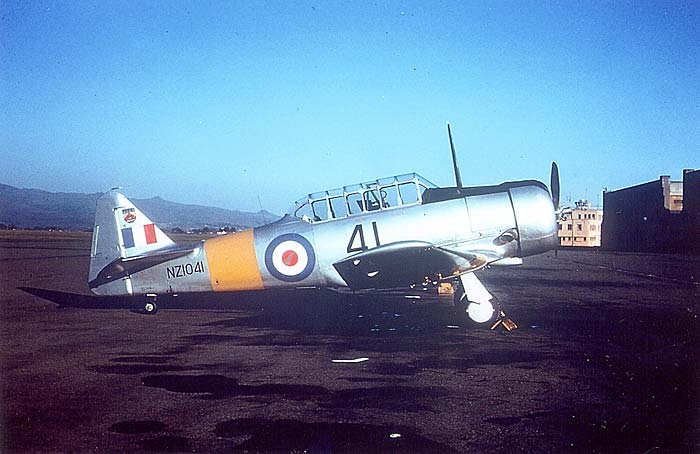 |
| NZ1041 in post-war training colours at Wigram. (Robert Montgomery collection) |
The above photograph of NZ1041 in post-war training colours at Wigram would have been taken ca. 1959-60; the decal presentation of the fern leaf in the "flying butter-box" roundel was not introduced until then, and the change from yellow bands to Fire Orange (Dayglo) areas was gazetted (from memory) in May 1960.
National Insignia was of the post-war D-Type, introduced by the RNZAF in 1949, and applied in "Bright Ident" colours:
Aircraft Blue BS381C No.108 (no direct Fed Std 595 equiv, darker version of 15180, heading toward 15056).
Post Office Red BS381C No.538 (Fed Std 11136)
Golden Yellow BS381C No.356 (Fed Std 13538 - some variation toward 13432)
Serials (on fuselage sides and under mainplanes) and "last two" (below cockpit) were applied in Gloss Black, with the "last two" repeated in Yellow on the upper cowling rim. Propeller blades were Black, with the usual 4" Yellow tips front and read, with tech-info in 1" Yellow stencils length-wise on the front face of each blade.
Ciry of Christchurch Coat of Arms
The Shield of the City of Christchurch (not the "full" Coat of Arms) appears above the fin; Across the top, on a mid-blue fleld, are the "First For Ships (the "Charlotte Jane", "Randolph", "George Seymour" and "Cressy", which brought the "Canterbury Pilgrims" to Lyttelton in December 1850). Below this the Shield is predominantly white, with a red Chevron edged in black, upon which are depicted a sailing ship (left), a Sheep (centre) and a wheat-stook (right). Below, and partly enclosed by the Chevron are undulating lines of mid-blue and white, again with black edging, representing the sea - undulating because the Shield is for a place "beyond the sea", ie., outside the coasts of Great Britain. Around 1957 the "Freedom of the City" (the right of service personnel to march through the steets, drums beating, bands playing, bayonets fixed, etc, etc) was conferred on the following RNZAF Stations; Whenuapai (by the City of Auckland), Ohakea (by the City of Palmerston North), Woodbourne (by the Borough of Blenheim) and Wigram (by the City of Christchurch. Aircraft based at Whenuapai, Woodbourne and Wigram wore the Shield or Coat of Arms of "their" City (or Borough, in the case of Woodbourne), however I have no knowledge of any Ohakea-based aircraft being marked with that for Palmerston North.
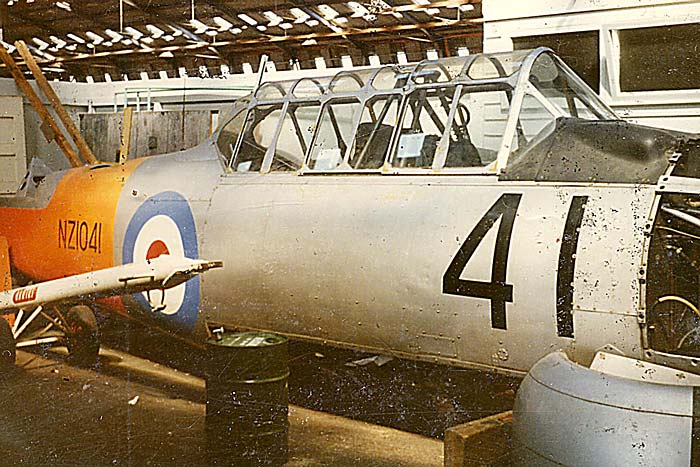 |
| Another photograph of NZ1041 in post-war training colours. (Robert Montgomery collection) |
Purchase by the National Airways Corporation (NAC)
On October 8th, 1971, two Harvards were passed for disposal via the Government Stores Board; of these, NZ1041 went to Air New Zealand's Training School at Auckland International Airport. I have attaxched a colour photo of NZ1041's fuselage, still with "41", Roundel and Yellow Tj-Band, in one of NAC's Hangars at Harewood, prior to its transfer to Auckland in 1972. Included are three pictures taken at Mangere, showing NZ1041 in Air New Zealand colours.
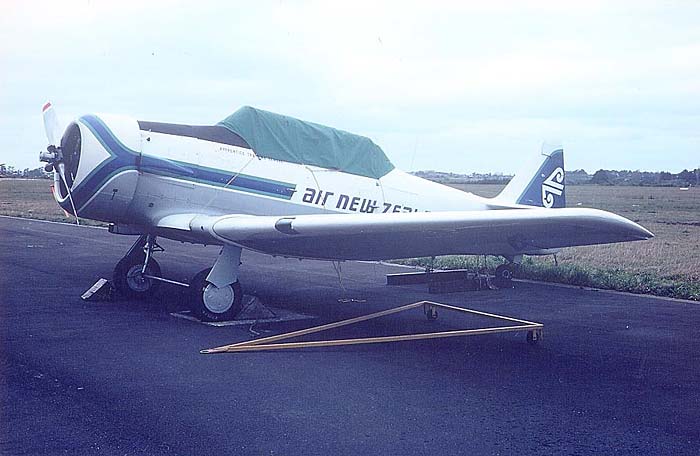 |
| NZ1041 at Mangere, Auckland, in Air New Zealand colours. (Robert Montgomery collection) |
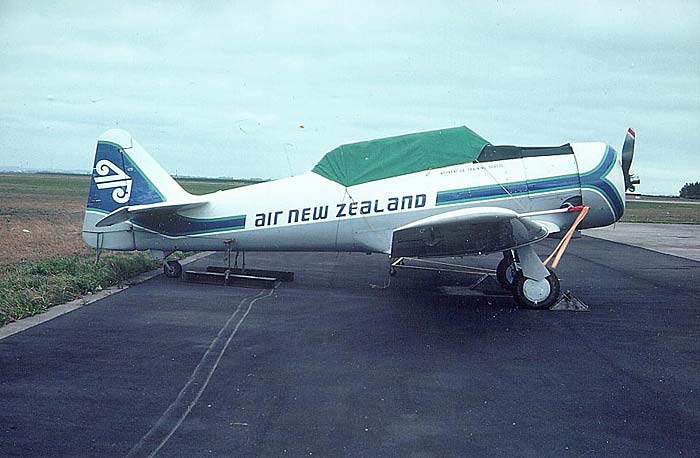 |
| NZ1041 at Mangere, Auckland, in Air New Zealand colours. (Robert Montgomery collection) |
 |
| NZ1041 at Mangere, Auckland, in Air New Zealand colours. (Robert Montgomery collection) |
NZ1041 was subsequently bought by John Saunders and is now stored in Marlborough. I understand he plans to restore it to its wartime identity, when with No.4 (F) OTU. John Sanders supplied the report on NZ1041's first wartime accident. The second one came from the Museum, via David Duxbury.
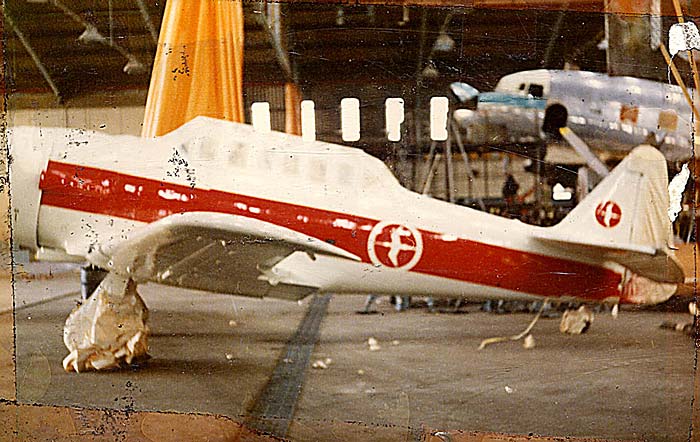 |
| NZ1044 in NAC colours. (Robert Montgomery collection) |
The second Harvard transferred to "airline service" was NZ1044, which went to the National Airways Corporation (NAC) technical Training School at Harewood. I have no information on its "life after NAC".
Click here to view Harvard decals at the Ventura Publications on-line shop
© Copyright 2004-2013 VenturaPublications.com and contributors.
|